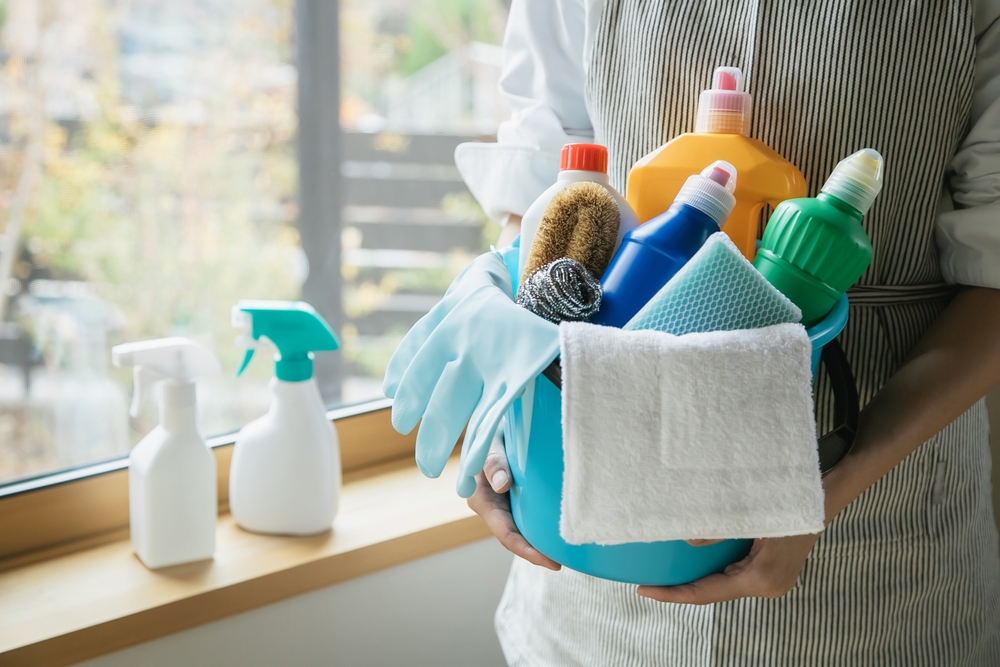A groundbreaking $1.5 million settlement against Rust-Oleum Corporation may tell consumers who’ve thought they've been keeping their home safe with "non-toxic" cleaning products a different story.
The Krud Kutter class action lawsuit alleges trusted household cleaners marketed as "Earth Friendly" actually contained harmful chemicals that could endanger your family, pets, and the environment.
As households across America examine their cleaning cabinets with fresh skepticism, the case highlights how even trusted brands may mislead consumers who seek genuinely safe alternatives.
Behind the Rust-Oleum Greenwashing Claims
Rust-Oleum Corporation built a marketing empire on two simple words: "NON-TOXIC."
The company plastered this claim across 15 different Krud Kutter cleaning products, from the Original Cleaner & Degreaser to the Tough Task Remover. And each product bore the same promise—safety for humans, animals, and the environment.
However, allegations in a recent class action lawsuit paint a starkly different picture.
Product mislabeling
According to court documents filed by plaintiffs, Rust-Oleum engaged in systematic product mislabeling that violated federal regulations and California consumer protection laws.
The company marketed its household cleaners as eco-friendly solutions while knowing they contained chemicals that could cause:
- Severe eye damage and irritation
- Skin burns and sensitization
- Respiratory problems when inhaled
- Environmental harm to plants and soil organisms
False Advertising
Rust-Oleum's alleged false advertising went beyond simple exaggeration. According to the lawsuit, the company’s green marketing strategy capitalized on consumers' growing demand for safer cleaning alternatives.
And as the eco-friendly cleaning market surged toward its projected $40 billion valuation by 2025, class plaintiffs say Rust-Oleum falsely positioned Krud Kutter as a responsible choice for health-conscious families.
Federal Agency Warnings Ignored
The Federal Trade Commission's Green Guides specifically warn against unsubstantiated "non-toxic" claims. The Environmental Protection Agency has also stated that marketers would "rarely, if ever," be able to substantiate such broad safety claims adequately.
Yet attorneys litigating this class action say Rust-Oleum proceeded with this marketing approach across their entire Krud Kutter product line.

Harmful Ingredients Hidden Behind "Non-Toxic" Labels
The disconnect between Krud Kutter's marketing claims and actual chemical composition has shocked consumers who trusted these products.
Laboratory analysis and Safety Data Sheet evidence from the lawsuit revealed a cocktail of potentially harmful substances lurking beneath Rust-Oleum’s "non-toxic" labels.
Alcohol Ethoxylates topped the list of concerning ingredients. These surfactants, present in concentrations up to 10% in several Krud Kutter products, can cause skin and eye damage upon contact. Even more troubling, these chemicals are phytotoxic, meaning they harm plants despite the "Earth Friendly" labeling.
Sodium Metasilicate presents another serious concern. This highly corrosive substance creates extreme alkalinity in several Krud Kutter products:
- Instant Carpet Stain Remover Plus Deodorizer: pH 12.69
- Tough Task Remover: pH 12.7
- Multi-Purpose House Wash: pH 12.7
- Original Cleaner & Degreaser (Aerosol): pH 12.4
Any substance with a pH above 11.5 can cause chemical burns to the skin and eyes, far exceeding what any reasonable consumer would expect from a "non-toxic" cleaner.
Other hazardous substances listed in the plaintiff’s lab analysis include:
- Dipropylene Glycol Monomethyl Ether - classified as hazardous in Safety Data Sheets
- Monoethanolamine - can cause respiratory irritation and skin sensitization
- Potassium Hydroxide - a caustic substance that burns on contact
- n-Butane (in aerosol products) - a flammable propellant with neurological effects
Perhaps most damning, each product's Safety Data Sheet carried signal words like "DANGER" or "WARNING"—directly contradicting the "non-toxic" claims on the front label.
Who Can File a Claim in the Krud Kutter Class Action
The settlement opens doors for millions of consumers who purchased these products under false pretenses. Understanding eligibility requirements helps affected households determine their rights to compensation.
Geographic Requirements: Only U.S. residents qualify for the settlement. The class action covers purchases made anywhere within the United States, whether from major retailers, hardware stores, or online platforms.
Covered Products: The settlement encompasses 15 specific Krud Kutter brand products that carried the disputed "Non-Toxic" and "Earth Friendly" labels:
- Adhesive Remover
- Instant Carpet Stain Remover Plus Deodorizer
- Original Cleaner & Degreaser
- Tough Task Remover
- Sports Cleaner/Stain Remover
- Gutter & Exterior Metal Cleaner
- Kitchen Degreaser & All Purpose Cleaner
- Heavy Traffic Carpet Cleaner
- Deck & Fence Wash
- Multi-Purpose House Wash
- Window Wash
- Parts Washer Cleaner/Degreaser
- Driveway Cleaner & Degreaser
- Original Cleaner & Degreaser (Aerosol)
- Tough Task Remover (Aerosol)
Purchase Requirements: Consumers must have bought these products for personal or household use—not for resale or commercial distribution. The purchase timeframe spans nearly a decade, covering transactions made during the height of the green cleaning movement.
Proof Considerations: While receipts strengthen claims, they aren't mandatory. Consumers without documentation can still participate by completing claim forms under penalty of perjury. This provision recognizes that most households don't retain cleaning product receipts for years.
Understanding Compensation in the Settlement Fund
The $1.5 million settlement fund creates a structured compensation system designed to distribute payments fairly among all valid claimants.
Base Compensation Structure
- $1.00 per product for all valid claims
- No limit on products claimed with receipts
- Maximum of eight products without receipts
Pro-Rata Adjustments
The settlement includes an innovative pro-rata provision. If total claims fall below the net settlement fund, each payment increases proportionally to $2.00 per product maximum.
Conversely, payments decrease proportionally if claims exceed available funds to ensure everyone receives compensation.
Net Settlement Fund Calculation
The $1.5 million total undergoes several deductions:
- Settlement administration costs
- Notice and publication expenses
- Court-approved attorneys' fees
- Service awards for class representatives
These standard deductions in class action settlements typically leave 60-70% for consumer distribution, though exact amounts depend on court approval and administrative efficiency.
Payment Distribution Timeline
Settlement payouts follow a predictable pattern in class actions. After court approval, the settlement administrator processes claims, verifies eligibility, and calculates pro-rata adjustments. Payments typically arrive within 60-90 days of final approval, assuming no appeals delay the process.
What Rust-Oleum Has Agreed to Do
Beyond monetary compensation, the settlement mandates fundamental changes to how Rust-Oleum markets Krud Kutter products.
These reforms aim to prevent future deception and protect consumers seeking genuinely safe cleaning alternatives.
Removal of "Non-Toxic" Claims
Rust-Oleum must eliminate all "NON-TOXIC" representations from Krud Kutter packaging and marketing materials. This sweeping change affects product labels, websites, advertisements, and promotional materials.
Modified "Earth Friendly" Claims
Rather than complete removal, the settlement allows modified environmental claims. Future "Earth Friendly" labels must include an asterisk directing consumers to qualifying language on the back panel. This disclaimer must specify: "Contains no inorganic phosphates, hazardous solvents or environmentally harmful surfactants."
Implementation Timeline
While specific deadlines remain confidential, typical settlements require labeling changes within 6-12 months. This directive allows companies to exhaust existing inventory while ensuring swift market correction.
Turning Point for Truth in Green Marketing
Manufacturers have exploited consumer trust with meaningless "non-toxic" labels for too long. This $1.5 million judgment demonstrates that false environmental claims carry real consequences.
Moving forward, this case may establish important precedents. Companies can no longer hide behind vague green marketing while selling products containing hazardous chemicals. The required labeling changes will force transparency and may compel companies to make specific disclaimers rather than broad generalizations.
Frequently Asked Questions (FAQ)
The settlement covers 15 Krud Kutter products labeled as "Non-Toxic" and "Earth Friendly," including Original Cleaner & Degreaser, Tough Task Remover, Kitchen Degreaser, Heavy Traffic Carpet Cleaner, Window Wash, and their aerosol versions. All sizes and packaging types of these products are included if they carried the disputed environmental claims during the class period.
Class members receive $1 per product purchased, with potential pro rata increases up to $2 per product if the settlement fund permits. Those with receipts can claim unlimited products, while those without proof of purchase can claim up to eight products by completing the claim form under penalty of perjury.
Despite "non-toxic" labeling, the products contained Alcohol Ethoxylates (causing skin/eye damage), Sodium Metasilicate (creating dangerous pH levels above 12), and other hazardous substances like Monoethanolamine and Potassium Hydroxide. Safety Data Sheets revealed these products carried "DANGER" warnings contradicting their marketed safety claims.
Rust-Oleum must remove all "Non-Toxic" claims from Krud Kutter packaging and add qualifying language to any "Earth Friendly" claims, specifying exactly what environmental benefits the products offer. These labeling changes aim to prevent future consumer deception and ensure compliance with FTC Green Guides and federal regulations.



Add Comment